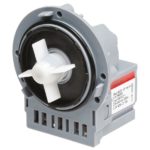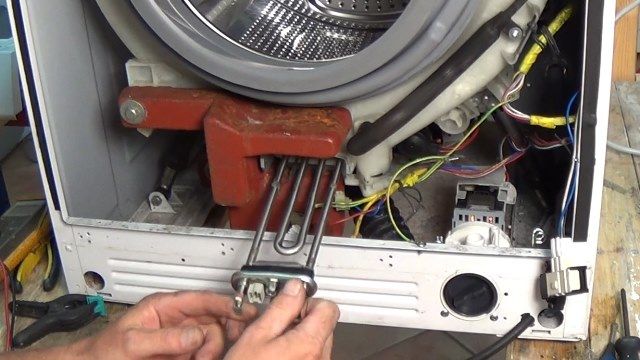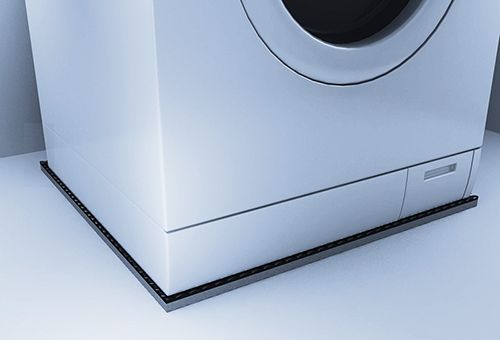How to get rid of mold in a washing machine
An automatic washing machine makes the housewife’s work easier and saves time. After all, while the laundry is spinning, you can do other household chores. But after a couple of years of use, washed clothes acquire a stale smell, and light-colored items develop a grayish tint.
 The reason for this phenomenon lies in the contamination of the washing machine, or more precisely in the occurrence of mold. It is fungal formations that give laundry an unpleasant odor after washing and partially neutralize the active components of powders and gels.
The reason for this phenomenon lies in the contamination of the washing machine, or more precisely in the occurrence of mold. It is fungal formations that give laundry an unpleasant odor after washing and partially neutralize the active components of powders and gels.
But there is no need to change the unit itself, because mold can be removed using home remedies that are found in every kitchen and medicine cabinet.
The content of the article
Mold control methods
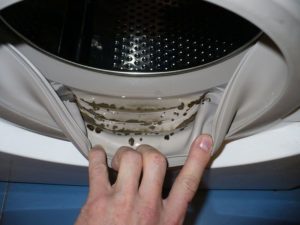 When starting to clean your washing machine from fungal stains, you should remember that one wash cycle will not help. It is necessary to carry out a whole complex that is aimed at getting rid of mold in all parts of the unit. This includes cleaning the machine itself inside and out, washing the area where it is installed, and preventive measures.
When starting to clean your washing machine from fungal stains, you should remember that one wash cycle will not help. It is necessary to carry out a whole complex that is aimed at getting rid of mold in all parts of the unit. This includes cleaning the machine itself inside and out, washing the area where it is installed, and preventive measures.
First steps – this is checking and washing the filter of the drain pump and the water supply.To do this you need:
- Open the lid at the bottom right and unscrew the filter.
- Rinse it under running water.
- Screw back and close the lid.
Second step – this is washing the filter on the water supply. This mesh does not collect as much debris as a drain, but it is there. Therefore you need:
- Turn the unit with the back wall towards you.
- Shut off the water supply to the machine.
- Unscrew the hose and pull out the filter mesh.
- Rinse it under running water.
- Insert the mesh back.
- Screw on the hose.
 Third step - This is the treatment of the part where the washing machine is installed. While it is pulled out, you can treat the surfaces, that is, the walls and floor. You need to carefully inspect everything for the presence of mold. If there are no visible traces, then only preventive measures can be taken. This:
Third step - This is the treatment of the part where the washing machine is installed. While it is pulled out, you can treat the surfaces, that is, the walls and floor. You need to carefully inspect everything for the presence of mold. If there are no visible traces, then only preventive measures can be taken. This:
- Rinse the walls and floor with the product you regularly use for such purposes.
- After 10 minutes, spray the surfaces with a vinegar solution prepared in a one-to-one ratio.
- Wait until it dries and only then install the unit in place.
If clear traces of fungus are observed, it should be washed with the mixture, regardless of the surface. To prepare it you need:
- aqueous solution of boric acid - 1 tbsp;
- 2 tbsp each pharmaceutical hydrogen peroxide and ordinary table vinegar;
- 4 tbsp. l. water.
Mix all ingredients and heat until your hand can handle it. Using the resulting mixture and a brush, wash off the mold until it completely disappears. If you didn’t manage to wash out the fungal stains the first time, then after a few hours you can repeat the procedure with a freshly prepared product.
Attention! When cleaning mold from your machine, it is recommended to protect your hands with long rubber gloves, available at hardware stores, and a face mask to help prevent inhalation of fumes.
You can wipe the washing machine with the same solution if there are traces of mold on it. If there is no fungus on the surface of the unit, it is enough to wipe it with vinegar diluted with water in equal proportions. After the above manipulations, you can install the washing machine in place.
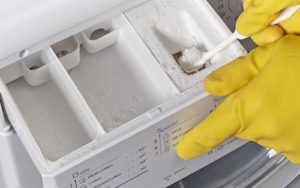 Now you need to wash the tray where the powder is poured and the conditioner is poured. For these purposes, baking soda or the above-described mixture with boric acid and an old toothbrush are suitable. For large volumes of fungal stains, you can use Domestos, diluted with water in equal parts. The tray should be washed until it is clean, until plaque and other contaminants disappear. After this, the part must be dried and installed in place.
Now you need to wash the tray where the powder is poured and the conditioner is poured. For these purposes, baking soda or the above-described mixture with boric acid and an old toothbrush are suitable. For large volumes of fungal stains, you can use Domestos, diluted with water in equal parts. The tray should be washed until it is clean, until plaque and other contaminants disappear. After this, the part must be dried and installed in place.
Next step - This is cleaning the insides of the unit. Suitable for these purposes:
- chlorine-containing detergents;
- vinegar;
- lemon acid.
At the initial manifestations of mold, you can wash at temperatures above 60 degrees, pouring 400 g of citric acid directly into the drum with a volume designed for 5 kg. If fungal stains have already “lived” for a long time inside the machine, then you can use a chlorine-containing product, for example, “Domestos” or “Toilet duck” with chlorine. It is advisable to open the windows while washing with such preparations.
To thoroughly clean your washing machine you need:
- Pour 1 liter of chlorine-containing product into the tray.
- Turn on the unit for a long wash at a temperature of at least 60 degrees.
- After 30-40 minutes, press pause and leave the machine for at least 1 hour.
- After this, continue the cycle.
- After draining and the “spin” operation, when the conditioner is requested, pour 500 ml of ordinary vinegar into the tray.
- Turn on rinse.
- It is recommended to repeat rinsing 2 more times.
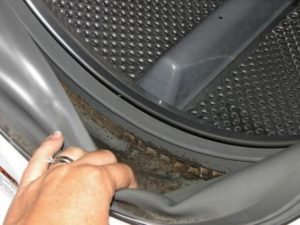 After all the operations performed, there is one more thing left to do - carefully inspect the sealing gum. If there are still traces of mold on it, then you need to take pharmaceutical hydrogen peroxide and use a brush to clean off the stains. When the fungus on the cuff has not disappeared even after such cleaning, the best solution is to replace it.
After all the operations performed, there is one more thing left to do - carefully inspect the sealing gum. If there are still traces of mold on it, then you need to take pharmaceutical hydrogen peroxide and use a brush to clean off the stains. When the fungus on the cuff has not disappeared even after such cleaning, the best solution is to replace it.
Important! The full procedure for cleaning a washing machine from mold, which is described above, takes a lot of time, so you should be prepared to carry it out from start to finish, observing all time periods.
Fungus control agents
To remove mold in a washing machine you can use:
- table vinegar;
- citric acid;
- soda;
- copper sulfate;
- hydrogen peroxide;
- aqueous solution of boric acid;
- special cleaning products for washing machines.
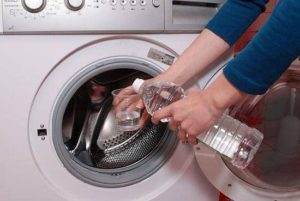 When starting to clean the unit, you need to determine the degree of fungal infection. If the stain can be wiped off with a damp cloth, then this is the initial stage. With more serious manifestations, the place where mold appears only becomes slightly lighter. To remove such stains, you will have to use radical measures with chlorine-containing substances.
When starting to clean the unit, you need to determine the degree of fungal infection. If the stain can be wiped off with a damp cloth, then this is the initial stage. With more serious manifestations, the place where mold appears only becomes slightly lighter. To remove such stains, you will have to use radical measures with chlorine-containing substances.
Attention! It is contraindicated to use antifungal agents that are intended for treating walls, ceilings or other building surfaces when cleaning a washing machine. The active substance has a more aggressive effect and can damage unit parts.
How to use citric acid, vinegar, peroxide and boric acid is described above, and you need to prepare a slurry from soda and copper sulfate.To prepare:
- Take 50 g of the substance.
- Dilute with a little water - approximately 2 tbsp.
- Then mix well to obtain a homogeneous consistency.
The resulting slurry is good for cleaning the cuff, tray and other areas of the unit where there are minor fungal formations.
Special products that are specifically designed for cleaning the machine should be used according to the attached instructions. In this case, all precautions described in it must be observed.
The most effective remedy
As practice shows, one of the most optimal means that destroys mold is citric acid or vinegar. Housewives prefer the first one, since after its use a more pleasant aroma remains.
How can you clean mold from a washing machine?
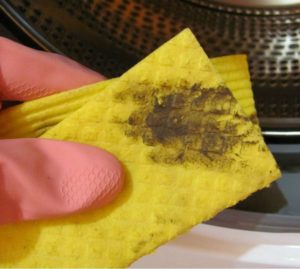 The list of methods for cleaning a machine from fungal stains is small. After all, the main methods of combating mold are:
The list of methods for cleaning a machine from fungal stains is small. After all, the main methods of combating mold are:
- in a high-temperature wash cycle using acids;
- in brushing;
- in wiping dry the parts of the unit;
- in ventilation of the machine and the room where it is installed.
Mold does not like exposure to acids and high temperatures. Therefore, you can use an ultraviolet lamp, which should be directed at the drum.
You can also do something radical by calling a specialist to your home. The specialist disassembles the washing machine, and the owner washes all the parts using the above products. But this method is not cheap and it is worth using it in cases where it is difficult to get to the mold areas.
Another method for eliminating mold inside the washing machine.It is used only when the machine has been in use for a long time and all means have not led to the desired result. This is a replacement of parts affected by fungus, or rather the rubber seal, drain hose and others.
Why does mold appear in the machine?
The formation of fungal stains is promoted by humidity and twilight. Economy modes, in which the water does not heat above 40 degrees, also have a bad effect on the condition of the unit. In addition, the appearance of mold is promoted by:
- use of rinse aid;
- lack of cleaning parts from scale using special means;
- use of powders without bleach;
- frequent use of gel detergents for washing;
- lack of ventilation of the room where the machine is installed;
- constant humidity inside the washing machine;
- poor maintenance of the unit.
What measures will prevent mold from occurring?
 To avoid having to deal with fungal stains, you need to properly care for your washing machine. That is:
To avoid having to deal with fungal stains, you need to properly care for your washing machine. That is:
- Use a washing cycle with a temperature above 60 degrees, or even better 90, at least once every 2 weeks. Even if there is no need for such a cycle, you can start it with an empty drum.
- Immediately remove washed clothes from the machine.
- Do not put dirty laundry inside in advance, but only before the process itself.
- Do not use products with a gel base, and if there is no other option, then run an additional rinse after washing. The same should be done when using balms, conditioners and rinses.
- Rinse the powder tray after each wash.
- Periodically use anti-scale agents and clean the unit.To clean, just pour 300–400 g of citric acid into the drum and run a cycle with a water temperature of 60 degrees. A similar procedure should be carried out 1-2 times a month. Anti-scale agents are used according to the instructions.
- Clean filters regularly.
- After washing, wipe all parts of the machine dry with a napkin and leave the doors open or half-open.
- Clean tubes and hoses periodically using vinegar and water.
What should be included in a wash cycle?
Every housewife should accustom herself to running an additional rinse after washing with an empty drum and wiping accessible parts dry. And after manipulations, leave the doors half open.
For prevention, you can reinstall the unit. If the machine is in the bathroom, then it is recommended to move it to the kitchen or hallway (depending on the layout and design project). When this is not possible, you need to install forced ventilation to reduce the humidity in the bathroom.
Why shouldn't fungal stains be left behind?
Danger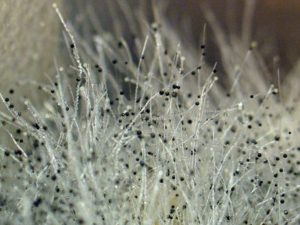 The main thing about mold, wherever it is, is its negative impact on the body. Disputes provoke the appearance of various diseases of the upper respiratory tract in households, or rather bronchitis, asthma, tracheitis, allergic reactions and others.
The main thing about mold, wherever it is, is its negative impact on the body. Disputes provoke the appearance of various diseases of the upper respiratory tract in households, or rather bronchitis, asthma, tracheitis, allergic reactions and others.
When mold gets from the washing machine parts onto clothes, it causes irritation, difficulty breathing and provokes respiratory diseases. In addition, after washing, clothes do not look very neat and often have an unpleasant smell. And it turns out that dirty laundry looks better than washed laundry.
If there is mold in the washing machine, to achieve quality in the process, housewives begin to pour in larger amounts of powder, which leads to increased consumption of funds. And as a result, high washing costs. Therefore, it will be cheaper to destroy the fungus in the washing machine than to ignore its presence.
A good housewife is one who knows how to rationally spend the family budget. By spending a small amount on the purchase of citric acid, vinegar, soda and other products, you can save on aromatic conditioner, washing powder and other preparations. After all, having gotten rid of the fungus, there will be no need to neutralize the unpleasant odor that the laundry acquires in the machine.


